So, you’ve decided to conquer the GMAT—brave soul. But wait… just as you’re getting comfortable with Quant and Verbal, along comes the Data Insights (DI) section with its own twisty flavor of questions. One of the trickiest? You guessed it: Two-Part Analysis (TPA).
Imagine a question that’s like a riddle married a math problem and then invited logic to the party. That’s TPA for you—twice the trouble, twice the fun!
But don’t worry, you’re not alone. According to the Graduate Management Admission Council (GMAC), over 200,000 people take the GMAT each year, and more than 70% of top scorers say DI requires a strategic mindset, not just raw smarts (GMAC 2023 Prep Survey). So, if you’ve ever stared at a TPA question thinking, “Is this a math puzzle, a logic gate, or just a cruel joke?”—you're in excellent company.
In this guide, we’ll break down TPA questions in a way that’s painless, practical, and hey, maybe even a little fun. Whether you’re a spreadsheet ninja or allergic to word problems, this is your map to decoding GMAT’s sneaky two-parters—with humor, heart, and hacks that actually work.
Two-Part Analysis Questions: Structure and Format
The Two-Part Analysis (TPA) question type in the GMAT Data Insights section is designed to test your ability to evaluate two related aspects of a problem. These questions often require logical reasoning, quantitative skills, or critical thinking—and sometimes, all three at once!
What’s the Format Like?
Here's what you’ll see on screen:
A question stem (a brief scenario or problem)
A table with two columns labeled Part 1 and Part 2
A shared list of 5-6 answer choices that apply to both parts
You must select one answer for each column (they can be the same or different)
Important Rule: You only get credit if both answers are correct. Half-right is still all wrong!
Example Question of TPA
A company is considering two investment options, Project X and Project Y. Project X yields a 20% return over 2 years. Project Y gives a 10% annual return, compounded yearly. Assume the company invests $10,000 in each project.
Question:
Based on the information, answer the following:
Part 1: Which project yields a higher return after 2 years?
Part 2: What is the total profit from the better-performing project?
| Answer Choices | |
|---|---|
| Part 1 | ○ Project X |
| ○ Project Y | |
| Part 2 | ○ $1,000 |
| ○ $2,000 | |
| ○ $2,100 | |
| ○ $2,200 | |
| ○ $2,400 |
How Do You Solve It?
Let’s break it down:
Project X: 20% return on $10,000 over 2 years = $2,000 profit
Project Y: 10% compounded yearly →
Year 1: $10,000 × 1.10 = $11,000
Year 2: $11,000 × 1.10 = $12,100 → $2,100 profit
So:
Part 1 Answer: Project Y
Part 2 Answer: $2,100
Great! Here's a breakdown of the Types of Two-Part Analysis (TPA) Questions in the GMAT Data Insights section. Each type includes a friendly explanation and an illustrative example.
Types of Two-Part Analysis Questions (TPA)
Quantitative-Based TPA
Your ability to apply arithmetic, algebra, or basic math reasoning to solve a two-part problem.
Typical Scenario: You’re given a math-based situation with two questions that rely on computations or formula application.
Example:
A tank is being filled with water from two pipes. Pipe A can fill the tank in 4 hours, and Pipe B can fill it in 6 hours. Both pipes are turned on simultaneously.
Part 1: How long will it take to fill the tank if both pipes work together?
Part 2: If Pipe A is closed after 1 hour, how much longer will Pipe B need to finish filling the tank?
| Answer Choices | |
|---|---|
| Part 1 | ○ 2.4 hours |
| ○ 2.5 hours | |
| ○ 3 hours | |
| Part 2 | ○ 2 hours |
| ○ 3 hours | |
| ○ 4 hours |
Verbal-Based TPA
Your ability to read, understand, and analyze arguments or written scenarios.
Typical Scenario: You’ll be presented with a short passage and asked two questions—often related to assumptions, conclusions, or parallel reasoning.
Example:
A study suggests that students who sleep at least 8 hours the night before an exam score higher on average than those who don’t. A school administrator uses this to argue that all students should be required to get 8 hours of sleep before tests.
Part 1: Which assumption would most strengthen the administrator’s argument?
Part 2: Which statement, if true, would most weaken the argument?
| Answer Choices | |
|---|---|
| Part 1 | ○ Sleep causes better focus |
| ○ Students drink coffee before tests | |
| Part 2 | ○ Students can perform well despite little sleep |
| ○ Sleep is not the only factor in performance |
Logic-Based TPA
Your ability to apply rules or conditions logically—sometimes a mix of math and reasoning.
Typical Scenario: You're given constraints (like a seating chart, schedule, or conditional scenario) and must deduce the correct answers from the logic.
Example:
Five friends (A, B, C, D, and E) are to be seated in a row. A cannot sit next to B. D must sit to the right of C.
Part 1: Which of the following is a possible seating order?
Part 2: If A is in the first seat, which position must D occupy?
| Answer Choices | |
|---|---|
| Part 1 | ○ C, D, E, B, A |
| ○ B, A, C, D, E | |
| Part 2 | ○ 3rd position |
| ○ 5th position |
Common Challenges & Effective Strategies
| Common Challenges | Effective Strategies |
|---|---|
| Misunderstanding the relationship between the two parts | Read both parts together first, then re-read the question stem to understand context |
| Getting overwhelmed by data or long word problems | Break down the problem into smaller chunks; highlight key info and eliminate distractions |
| Wasting too much time on calculations | Use estimation, plug in simple numbers, or back-solve when possible |
| Choosing two answers independently | Always check if the two parts are logically or mathematically linked |
| Rushing and selecting partial answers | Remember: full credit only if both answers are correct—slow down and double-check |
| Struggling with logic-based or abstract questions | Draw a diagram or table to visualize conditions and eliminate impossible scenarios |
| Overthinking verbal-based scenarios | Focus on what’s directly supported by the passage—not assumptions or opinions |
| Difficulty in managing time on TPA questions | Set a mental time limit (e.g., 2.5 minutes) and move on if stuck—mark for review |
Practice Question 1
A nonprofit literary group in the United States is organizing a day long poetry event for the community. Five poets will read in the morning, and another five poets will read in the afternoon. To make sure that the poets engage a young audience, the literary group wants a majority of poets in one part of the event to be born after 1970. The other part of the event should have at least four women poets. Neither part of the event should have more than two poets from other countries. The literary group has already agreed on a plan for eight of the ten poets. That plan, showing names along with each poet’s birth year and country of origin, is shown here.
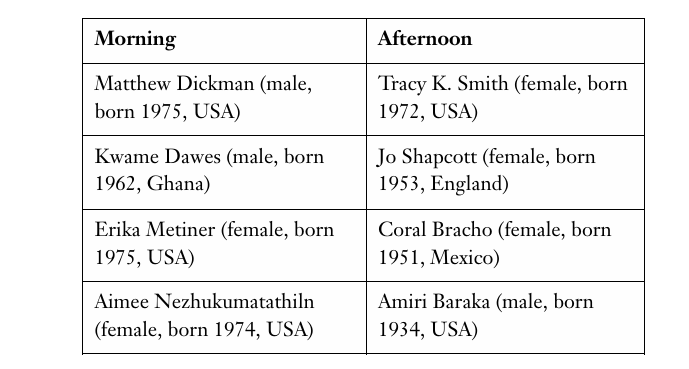
Select a poet who could be added to either the morning or the afternoon. Then, select a poet who could NOT be added to either the morning or the afternoon. Make only two selections, one in each column.
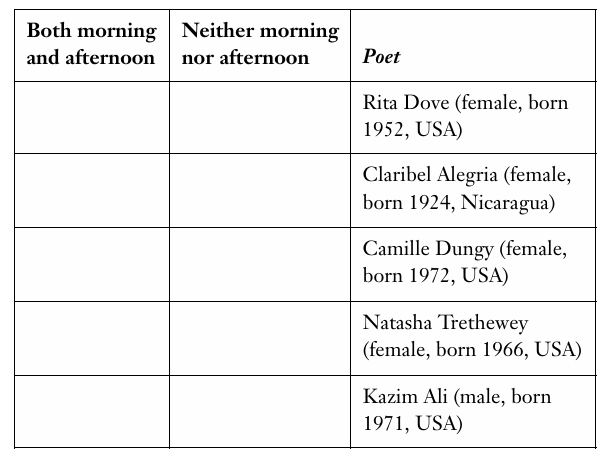
Answer 1
Column 1, line 3. The question asks about the poet who could be added to the event’s schedule for either morning or afternoon and fulfill the requirements. For column 1, lines 1, 2, and 4 are incorrect because if any of these poets were included in the morning or afternoon sections, then the morning section would not have four women poets or a majority of poets born after 1970. Line 5 is incorrect because if this poet were included, then the morning and afternoon sections would not have four women poets. Column 2, line 2. The question asks about the poet who could NOT be added to the event’s schedule for either morning or afternoon and fulfill the requirements. For column 2, lines 1, 3, and 4 are incorrect because any of these poets could be added to the afternoon in order for the afternoon to have four women poets. Line 5 is incorrect because this poet could be added to the morning in order for the morning to have a majority of poets born after 1970.
Practice Question 2
University A currently has 20,000 students enrolled. University B currently has 22,500 students enrolled. The number of students enrolling in University A and the number of students enrolling in University B increases each year, each at its own constant rate. The deans of the universities project that if each university maintains its constant rate of student enrollment increase, five years from now they will both have the same number of students enrolled, and University A will have more students enrolled than University B in subsequent years. In the following table, identify the rate of increase, in student enrollment per year, for University A and the rate of increase, in student enrollment per year, for University B that are both consistent with the deans’ projections. Make only one selection in each column.
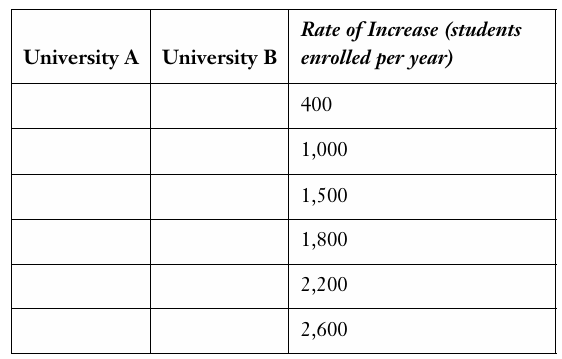
Answer 2
Column 1, line 3. The question asks about the rate of increase in student enrollment per year for University A that would cause University A and University B to have the same number of enrolled students in 5 years and for University A to have more enrolled students than University B after five years. For column 1, line 1 is incorrect because this would cause University A’s student enrollment to increase by 2,000 students, resulting in 22,000 students enrolled at University A. This will not equal University B’s enrollment. Line 2 is incorrect because this would cause University A’s student enrollment to increase by 5,000, resulting in 25,000 students enrolled in University A. There are no rates that would cause University B to also have 25,000 students in five years. Line 4 is incorrect because this would cause University A’s student enrollment to increase by 9,000, resulting in 29,000 students enrolled in University A. There are no rates that would cause University B to also have 29,000 students in five years. Line 5 is incorrect because this would cause University A’s student enrollment to increase by 11,000, resulting in 31,000 students enrolled in University A. There are no rates that would cause University B to also have 31,000 students in five years. Line 6 is incorrect because this would cause University A’s student enrollment to increase by 13,000, resulting in 33,000 students enrolled in University A. There are no rates that would cause University B to also have 33,000 students in five years.
Column 2, line 2. The question asks about the rate of increase in student enrollment per year for University B that would cause University A and University B to have the same number of enrolled students in 5 years and for University B to have fewer enrolled students than University A after five years. For column 2, line 1 is incorrect because this would cause University B’s student enrollment to increase by 2,000 students, resulting in 24,500 students enrolled at University B. There are no rates to cause University A to have 24,500 students in five years. Line 3 is incorrect because this would cause University B’s student enrollment to increase by 7,500, resulting in 30,000 students enrolled in University B. There are no rates that would cause University A’s enrollment to increase by 10,000 students in five years. Line 4 is incorrect because this would cause University B’s student enrollment to increase by 9,000, resulting in 31,500 students enrolled in University B. There are no rates that would cause University A’s enrollment to increase by 11,500 students in five years. Line 5 is incorrect because this would cause University B’s student enrollment to increase by 11,000, resulting in 33,500 students enrolled in University B. There are no rates that would cause University A’s enrollment to increase by 13,500 students in five years. Line 6 is incorrect because this would cause University B’s student enrollment to increase by 13,000, resulting in 35,500 students enrolled in University B. There are no rates that would cause University A’s enrollment to increase by 15,500 students in five years.
Practice Question 3
At a hot dog eating contest, one contestant ate at a constant rate of H hot dogs per minute (H hot dogs/min.). The contestant had burned calories from activity during the contest and taken in calories from eating the hot dogs for an overall caloric intake of C calories per hot dog (C calories/hot dog). In terms of the variables H and C, select the expression that best represents the number of calories taken in during one minute of eating at a constant rate. Then, select the expression that represents the number of calories taken in if the contestant had eaten 100 hot dogs at a constant rate of H. Make only two selections, one in each column
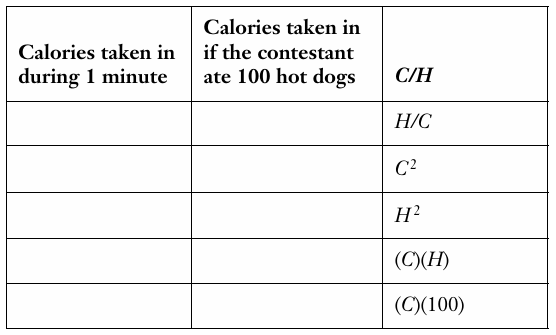
Answer 3
Column 1, line 5. The question asks about using two variables to determine the number of calories taken in during one minute of eating hot dogs at a constant rate. For column 1, line 1 (C/H) is incorrect because dividing the number of calories per hot dog by the rate at which the contestant ate hot dogs does not result in finding out the number of calories taken in during one minute. Line 2 (H/C) is incorrect because dividing the rate at which the contestant ate hot dogs by the number of calories per hot dog does not result in finding out the number of calories taken in during one minute. Line 3 (C2) is incorrect because this only involves the number of calories per hot dog and does not involve a unit of time. Line 4 (H 2) is incorrect because this only involves the number of hot dogs eaten over time and does not involve finding out the caloric intake. Line 6 (C)(100) is incorrect because this does not involve time.
Column 2, line 6. The question asks about using two variables to determine the number of calories taken in if the contestant ate 100 hot dogs at a constant rate. For column 2, line 1 (C/H) is incorrect because dividing the number of calories per hot dog by the rate at which the contestant ate hot dogs does not result in finding out the number of calories taken in from eating 100 hot dogs. Line 2 (H/C) is incorrect because dividing the rate at which the contestant ate hot dogs by the number of calories per hot dog does not result in finding out the number of calories taken in from eating 100 hot dogs. Line 3 (C2) is incorrect because this only involves the number of calories per hot dog and does not involve a specific number of hot dogs. Line 4 (H 2) is incorrect because this only involves the number of hot dogs eaten over time and does not involve finding out the caloric intake. Line 5 (C)(H ) is incorrect because it results in finding out the number of calories taken in from one minute of eating, not the number of calories taken in from eating 100 hot dogs.
Practice Question 4
The following excerpt from a fictitious science news report discusses a fictitious type of pollutant called tritans. For years, scientists have studied the effects of tritans on birds’ eggs, but recently scientists have also discovered that tritans affect other egg-laying species. Tritans were known to cause birds to lay their eggs too early and also weaken the shell of eggs. As a result, embryos in the eggs have less of a chance to survive. Fewer eggs resulted in live offspring, and the numbers of these species of birds diminished. Now, scientists recently discovered that the decreasing numbers of certain species of lizards has also been caused by tritans. These species of lizards tend to bury their eggs in sand nests, whereas the birds had nests in trees. Scientists are now researching the source of the tritans in order to limit tritans pollution in the environment. Based on the definition of the imaginary word tritans that can be inferred from the previous paragraph, which of the following traits of a pollutant must be true for that pollutant to be tritans and which must NOT be true for that pollutant to be tritans? Make only two selections, one in each column.
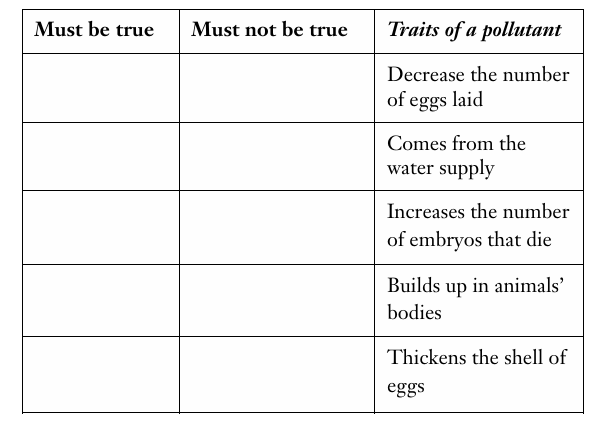
Answer 4
Column 1, line 3.The question asks about determining a trait that the imaginary pollution tritans has based on the details in the paragraph. For column 1, line 1 is incorrect because there are no details to suggest that tritans decrease the number of eggs laid. Line 2 is incorrect because the paragraph states that scientists are “researching the source of the tritans,” so this does not support the idea that tritans come from the water supply. Line 4 is incorrect because the paragraph is focused on the effects on eggs, not animals’ bodies. Line 5 is incorrect because the paragraph states that tritans “weaken the shell of eggs,” not thicken the eggshells.
Column 2, line 5.The question asks about determining a trait that the imaginary pollution tritans must NOT have based on the details in the paragraph. For column 2, line 1 is incorrect because there are no details in the paragraph to suggest that tritans do or do not decrease the number of eggs laid. Line 2 is incorrect because the paragraph states that scientists are “researching the source of the tritans,” so tritans could come from the water supply. Line 3 is incorrect because the paragraph states that fewer eggs survive, so this is a trait of titans. Line 4 is incorrect because there are no details about this in the paragraph, so it could be a trait of titans.
Practice Question 5
The following excerpt from a fictitious veterinary textbook discusses a fictitious type of disease called spurnit. The diagnosis of spurnit in dogs can be difficult as symptoms do not always manifest until the disease has progressed. Unlike other illnesses that cause an increase in swelling in the glands, spurnit does not, making early detection difficult. Nonetheless, early symptoms include a slightly swollen tongue and/or an elevated level of white blood cells. Early detection is key because the treatment of spurnit varies depending on the duration the dog has carried the disease. Early treatments can involve a simple course of antibiotics and then a year-long daily regimen of probiotics. Later stages of the disease often tend to resist all treatments, but daily blood transfusions have been shown to ease symptoms in certain cases. Based on the definition of the imaginary word spurnit that can be inferred from the previous paragraph, which of the following are definitely traits of spurnit and which of the following are definitely NOT spurnit? Make only two selections, one in each column.
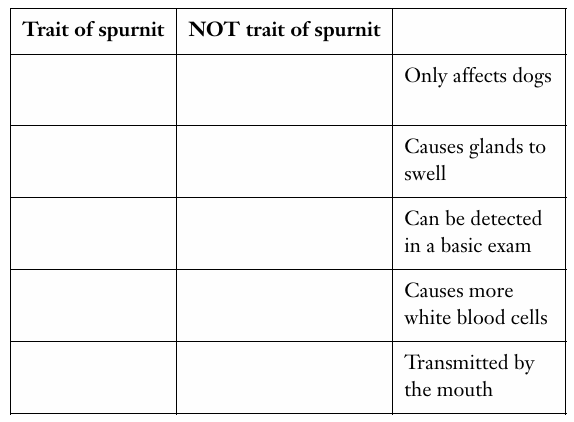
Answer 5
Column 1, line 4. The question asks about an imaginary type of disease called spurnit and a trait that spurnit definitely has. For column 1, line 1 is incorrect because, while the paragraph focuses on diagnosing the disease in dogs, the paragraph never states that the disease only occurs in dogs. Line 2 is incorrect because the paragraph states that spurnit is unlike diseases that “cause an increase in swelling in the glands.” Line 3 is incorrect because the paragraph states that detection “can be difficult.” Line 5 is incorrect because, while the paragraph states that the disease affects the tongue, the paragraph never describes the transmission of the disease.
Column 2, line 2. The question asks about an imaginary type of disease called spurnit and a trait that spurnit definitely does NOT have. For column 2, line 1 is incorrect because the paragraph describes diagnosing the disease in dogs. Line 3 is incorrect because, while the paragraph states that detection “can be difficult,” it also states that symptoms can manifest and be detected early. Line 4 is incorrect because the paragraph states that the disease results in an “elevated level of white blood cells.” Line 5 is incorrect because, while the paragraph states that the disease affects the tongue, the paragraph never describes the transmission of the disease.
Conclusion:
So, what’s the final takeaway? TPA questions may look like they’ve been designed by an evil game master from a parallel universe—but they’re absolutely conquerable.
If you can juggle two choices, stay calm under pressure, and learn to spot the logical link between parts like Sherlock Holmes with a calculator—you’re already ahead of the curve.
Here’s a fun stat to end on: GMAT test-takers who practiced 10+ targeted TPA questions per week showed a 23% improvement in their DI performance over a month (source: GMAT Club user survey, 2023). That’s not just encouraging—it’s proof that practice plus the right strategy = results.
So go forth, GMAT warrior! Armed with tips, tactics, and maybe a few corny analogies, you're ready to face the Two-Part Analysis dragon—and come out with a shiny score to show for it.
